Our first attempt toward adaptive dynamical systems was to develop the concept of adaptive frequency oscillators, which are oscillators that can adapt their parameters to learn the frequency of any periodic input signal. It means that they change their parameters in order to have an intrinsic frequency that corresponds to the frequency of the input. This mechanism go beyond mere synchronization since the new frequency stays encoded in the system, even if the teaching signal disappears and it works for any initial conditions.
Consider a generic oscillator with 2 state variables, forced by a periodic input signal F

where x and y are the state variables and omega controls the frequency of the oscillations. Note that we do not need a linear relation between the observed frequency and omega, we only need a monotonic relation. We can transform omega into a new state variable that has a dynamics on a slower time-scale and that follows the tendency of the oscillator to synchronize

With this rule, the oscillator will adapt its frequency to the frequency of ANY periodic signal and it will work for any initial conditions. Moreover the frequency will stay encoded in the system even if the input signal disappears. The oscillator will also dynamically track any change of frequency in the input. Note that the learning is embedded in the dynamics and that the rule is generic, it works for many different oscillators. It is then straightforward to build adaptive frequency oscillators from “traditional” oscillators.
The Adaptive Hopf oscillator is built from the original Hopf oscillator (in blue) to which we add the generic rule (in red)
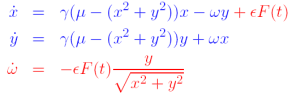
The next image shows an example of frequency adaptation when the oscillator is forced with a sinusoidal signal with a different frequency than the original frequency of the oscillator. The upper left graph shows the oscillator (plain line) and the input signal (dashed line) before adaptation, we notice that they have different frequencies. The lower left graph shows the two signals after adaptation, obviously the oscillator adapted to the correct frequency. The right graph shows the evolution of omega, we clearly see the convergence to the correct frequency.
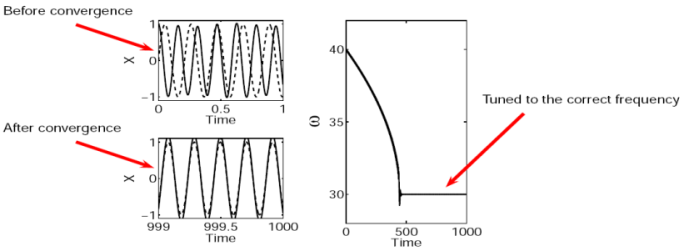
In the next example, the oscillators is forced with a chaotic signal (the Lorenz system), which does not have a well defined frequency. Nevertheless, the frequency converges near the pseudo-frequency (dashed line). This shows that the system can adapt to the frequency of any periodic input signal.
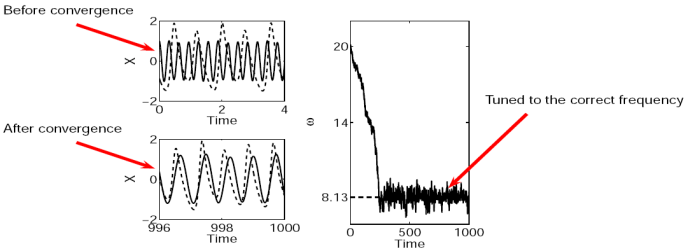
The Adaptive Fitzhugh-Nagumo oscillator is built directly from the original Fitzhugh-Nagumo oscillator (in blue) to which we add the generic rule (in red)
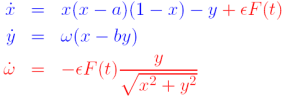
The next image shows an example of frequency adaptation when the oscillator is forced with a sinusoidal signal with a different frequency than the original frequency of the oscillator as we did for the Hopf oscillator. We clearly see that the oscillator learns the correct frequency (lower left graph). We must note that in this case the relation between the frequency of the oscillator and omega is nonlinear but the oscillator “finds” the correct value for omega such that the frequency of the oscillations is correct.
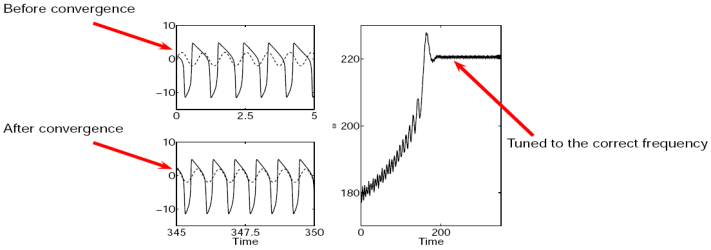
People involved: Jonas Buchli, Ludovic Righetti, Auke Ijspeert
Related student projects
- Vlad Trifa (Semester project 2005), Associative Memory Models Based on Coupled Oscillators
- Giorgio Brambilla (Master project 2005), Adaptive CPG for AIBO